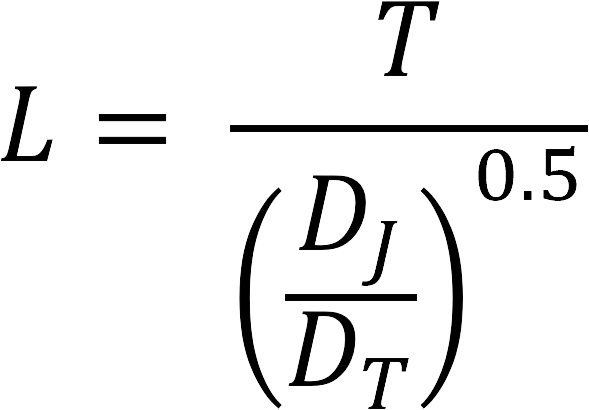Shaped Charge Hydrodynamic Limit Penetration Formula
|
Shaped Charge Hydrodynamic Limit Penetration Formula
|
Sources:
Technology of Tanks by Richard M. Ogorkiewicz
A Jet Penetration Model Incorporating Effects of Compressibility and Target Strength by William J. Flis
This equation is derived from Birkhoff's Hydrodynamic (incompressible) Bernoulli formula, and is known variously as:
Depending on who you ask.

OR

(both equations are the same mathematically; they're just different ways of showing a square root)

Where:
T = Thickness of Armor Penetrated (millimeters)
L = Length of Shaped Charge Jet (millimeters)
DJ = Density of Jet Material (kg/m3)
DT = Density of Target Material (kg/m3)
Hydrodynamic Limit Penetration CalculatorShaped Charge Jet Length Shaped Charge Liner Material Density Target Material Density Penetration (Length) |
The formula works really well when both the target and the shaped charge liner are made of the same thing, i.e. Steel Liner vs Rolled Homogenous Armor (RHA), and thus have unity (or near 1) ratios in densities. However, as target densities wildly diverge, so does penetration.
Another factor (found out by Eichelberger in Experimental Test of the Theory of Penetration by Metallic Jets [J. Appl. Phys. 27, 63–68 (1956)]) was that as the shape charge jet loses velocity, the compressive yield strength of both target and jet material comes into play. Effectively, at short standoffs and high jet velocities, the Hydrodynamic Limit formula works well, but breaks down as the jet slows down while penetrating extremely thick targets.
This is why if you put the exact same shaped charge against mild steel and Rolled Homogenous Armor (RHA), you'll get a totally different result, due to the difference in compressive/yield strengths of the two steels.
|
VALIDATION OF HYDRODYNAMIC FORMULA ON MULTIPLE TARGET MATERIALS: On Global Security (LINK), there's information about the penetration of the Charge, Demolition, Shaped, 150mm into various materials obtained through empirical testing. Additionally, we know that this charge has a steel liner, resulting in the following table below: |
||||
|
Target Material |
Target Density (g/cm3) |
Computed Penetration |
Actual |
Difference |
|
Armor Plate (RHA) |
7.86 |
178mm |
178mm |
0mm (0%) |
|
Mild Steel |
7.86 |
178mm |
250mm |
72mm (28.8%) |
|
Granite |
2.75 |
300.93mm |
380mm |
79.07mm (20.8%) |
|
Reinforced Concrete |
2.4 |
322.13mm |
760mm |
437.87mm (57.6%) |
|
Sandstone |
2.3 |
910mm |
329.05mm |
580.95mm (63.8%) |